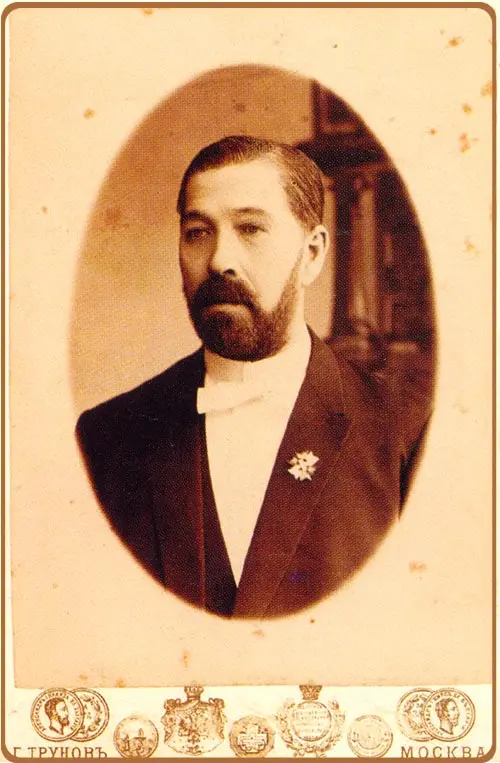Two centuries have passed since the creation of this drink, but the years, two revolutions and two world wars did not affect the reputation and did not violate the traditions of Smirnoff. International vodka from Britain, in which Russian roots are intertwined with American practicality, is sold in 130 countries around the world. And, despite the court litigation, it remains a successful brand, the leader of the world vodka market.
Historical reference. The trademark was created by Russian businessman Pyotr Smirnov, who inherited a small vodka distillery in Moscow founded in 1818 from his uncle Ivan Smirnov. The name “Smirnov” was given to the plant in 1860 after the reconstruction started by the new owner. The owner of the plant initially focused not on large volumes of products, but on quality, and therefore modernized the systems for purifying water, distillate and the final product. Vodka due to innovations turned out to be expensive, but of excellent quality, which became the reason for the popularity of the drink among aristocrats. In 1883, Alexander III appointed Peter Smirnov as a supplier of alcohol to the royal court; in 1884, supply proposals were received from the kings of Sweden and Spain.
When Pyotr Smirnov died in 1898, the plant was inherited by his sons Pyotr, Vladimir and Nikolai. But Nikolai was noticed by the brothers in excessive wastefulness and soon left the company. Vladimir was more interested in horses – having received half a million rubles from the inheritance, he became a horse breeder. The work of his father was continued by Peter, but in 1910 he died and Vladimir had to manage the plant. Before the revolutionary upheaval in 1917, the company annually produced up to four million bottles of vodka. The Bolsheviks who came to power expropriated the plant, and Vladimir Smirnov emigrated from Russia.

Vladimir tried to implement family recipes and acquired knowledge during his wanderings – first in Turkey, then in Poland. But there was too little known about Russian vodka, so attempts to popularize it were not successful. Fateful for the brand was Vladimir Smirnov’s meeting in Paris with his former grain supplier Rudolf Künneth, who now had his own distillery in Corbevoie. Kyunnet bought from Smirnov the exclusive rights to the family brand and the license for the production and distribution of vodka. In 1933, Ste. was incorporated in New York. Pierre Smirnoff Fils, and a year later the last Russian owner of the brand died.
Rudolf Künneth counted on the success of the new drink in the West, but in the world of gin and bourbon, vodka seemed superfluous, and in 1937 Künneth’s company was on the verge of bankruptcy. The rights to manufacture and sell Smirnoff were acquired by John Martin, head of Heublein. The advertising campaign organized by him in a matter of months made vodka famous in the United States.
Smirnoff was advertised as “colourless and odorless whiskey,” putting vodka on par with America’s favorite drink.
Advertisers with bartenders came up with the Moscow Mule cocktail, in which Smirnoff was the main ingredient – vodka was added with a lime wedge and ginger ale, and served in a copper mug. In the late XNUMXs, the Moscow Mule was America’s most popular cocktail.
Thanks to its organoleptic characteristics, Bloody Mary was made on the basis of Smirnoff, and then other alcoholic cocktails, which contributed to the adaptation of the Russian product to the American alcohol market.
Vodka Smirnoff in Russia
In 1992, a descendant of Peter Smirnov, Boris Smirnov, made an attempt to revive the great-great-grandfather’s business and establish the production of drinks according to grandfather’s recipes.
On his initiative, the distillery in Krymsk began to pour Smirnov vodka. Representatives of Heublein and Diageo, which owned the brand, reacted to this by filing a lawsuit demanding to ban production.
The company founded by Boris Smirnov filed a counterclaim, defending its right to produce vodka. The courts considered an endless number of counterclaims, and Boris Smirnov changed factories and continued to produce drinks. The Russian press covered the trials sparing no color. Diageo was charged with the theft of the brand, the distortion of its history, the raider seizure of the Smirnov trading house with the help of Alfa-Bank OJSC.
In 1992, Diageo representatives registered the Smirnoff trademark with Rospatent and entered into an agreement with Liviz CJSC, where Smirnoff is bottled for the Russian market to this day. In 2008, the British giant bought the company’s shares from Russian partners and became the sole and undisputed owner of the brand – both Smirnoff and the Russian version of Smirnov belong to him.
The company’s advertisers emphasize the Russian roots of the drink in order to maintain the image. So in 2016, the company released a limited batch of Matryoshka: Smirnoff Black vodka is poured into original aluminum vessels – a metal nesting doll with three onyx buttons.
Types of Smirnoff vodka
Smirnoff Red (37,5%). Crystal-clear premium class drink with a light vodka aroma. Harmonious organoleptic characteristics. It is served chilled to +6-8 °С. It goes well with dishes of Russian and European cuisine, with meat and vegetable snacks.
Smirnoff Black (40%). Perfectly clear vodka with a light anise-nutty aroma. Mild flavor with subtle hints of anise, Brazil nuts (Bertholletia) and licorice. In a short warming aftertaste, tones of black pepper are felt. Serve chilled to +6-8 °C. Sets off the taste of spicy snacks and meat cooked over an open fire.
Smirnoff Blue (50%). The strongest of Smirnoff vodkas with a classic vodka aroma and mild taste. It is served chilled to +5-8 °С. It goes well with meat, game, smoked meats and spicy vegetable snacks.










